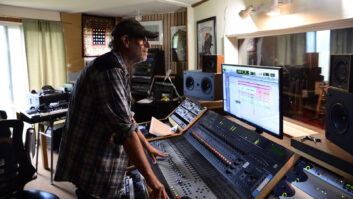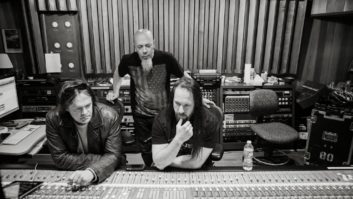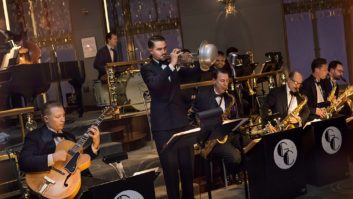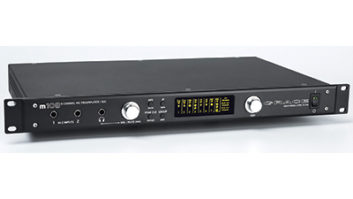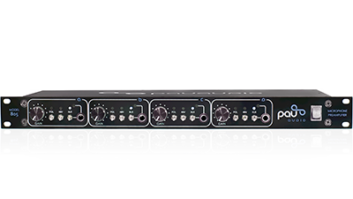Audio professionals are a cynical bunch. When it comes to new products — especially software-based products — they know that the path from concept to efficient reality is invariably long and difficult. The people at Steinberg Media Technologies AG are well aware of this skepticism, and as they make a foray onto the high-end DAW battlefield, they’ve been developing strategies to combat it.
Steinberg, best known for its Cubase MIDI sequencing software, is now jockeying for a leading position on the high end with the 24-bit, 96kHz Nuendo Media Production System. Two concepts were important from the beginning: The software had to be able to adapt to whatever computer technology is currently state-of-the-art, growing as both user needs and hardware evolve; and an open-design architecture, coupled with shared technical information, would create universal standards, benefiting Steinberg and the overall industry.
For Nuendo to succeed, there are some obvious hurdles. Is it really possible, both technically and financially, for a product to be all things to all people? And, can a small, European company — even one that’s highly successful in its niche — wrest share from a market that’s already firmly entrenched on a (de facto) standard platform? With its musician-friendly reputation and high-profile, Grammy Award-studded Nuendo user group, Steinberg is betting that the answer to both questions is “yes.”
THE ROOTS
Based in Hamburg, Germany, Steinberg was started in 1984 by Karl Steinberg and Manfred Rürup. Now, with almost 200 employees worldwide, the company produces more than 50 products; last year, Steinberg generated sales of approximately $20 million. Besides Cubase, Steinberg has also brought to market such innovative technologies as ASIO (Audio Stream Input Output) and VST (Virtual Studio Technology): real-time, software-only, open standards for digital signal processing.
In the early ’90s, Steinberg designers — many of them musicians who saw hardware-based systems as inherently limiting — began experimenting with the idea of a native DAW, a program that runs on a host computer without requiring proprietary, dedicated DSP or audio I/O hardware. Headed up by Wolfgang Kundras, the team came up with a multifaceted program but was caught in a Catch-22: No computer platform was powerful enough to run it. Those first editions of what became Nuendo ran on Unix-based Silicon Graphics computers. Early trade show previews of the program evoked positive response, along with the realization that the SGI platform was unlikely to be accepted in pro audio. When advances in more accepted operating systems created other options, the platform was switched to a Windows base. A year’s worth of beta testing at a post-production facility followed, and, in 2000, Nuendo V. 1.0 was launched.
Based on new code that incorporates ASIO and VST technologies, Nuendo offers, for both PC and Macintosh, a wide array of production applications, including MIDI, audio in stereo and surround, video and multimedia. Currently, the program provides up to 200 tracks of recording and mixing in 16, 24 and 32-bit floating point audio files with 44.1, 48, 88.2 and 96kHz sample rates. It accepts imports of .AIFF, AIFC, .WAV, Broadcast .WAV, MP3 and REX (SD2 on Mac) files, offers OMF import and export (making porting to and from Pro Tools possible) and supports, in real time, VST and Direct X plug-ins.
POWER USER NUMBER ONE
Nuendo evangelists use the word “transparent” a lot. But can something designed to support such a plethora of file protocols possibly be easy to run? It is, according to Grammy-winning engineer/producer Greg Ladanyi, who has joined with Steinberg to help with artist relations. Searching for a likely 5.1 surround format to remix Jackson Browne’s landmark Running On Empty for DVD-A, Ladanyi was convinced to give Nuendo a shot. Running On Empty, of course, is the perfect surround vehicle, documenting as it does songs recorded on the road in various acoustic environments, from hotel rooms and tour buses to full-blown concerts.
“I really knew nothing about Nuendo,” Ladanyi explains. “Rory Kaplan of DTS suggested that I talk to Steinberg’s Rob Hill because he knew that I wanted to work 24/96. Digital has always had the issue of coldness, along with the lack of both bottom end and open highs, but 24/96 has opened the door wide. That’s what I wanted. But, even though I’d worked with Pro Tools and Logic Audio for editing, I’d never been hands-on with a digital recording platform. Rob gave me a demonstration, and being able to do all the panning, processing and moves inside the computer really interested me. But what made Nuendo unlike any other digital platform I’d worked on is that you don’t ever have to stop the song to perform functions. It’s hands-on while you’re in motion. For me, that’s the way it has to be. I don’t want to have to stop the music to access things.”
The staff at Steinberg understands the time and budget pressures that today’s music projects contend with. Breaking into professional recording was the goal, but they knew that users wouldn’t come onboard if they had to cope with a steep learning curve. For the Running On Empty project, Hill signed on as co-engineer to ensure that the process ran smoothly.
“Although everyone embraced Nuendo’s technology,” Hill observes, “nobody was going to bleed on the cutting edge without our help. That’s where my role with Greg came in, to make it so he could keep working without flipping through a manual.”
Ladanyi admits that some blood was shed, in part because, instead of beginning with a “learning” project, he dove right in on Empty, starting with transferring 22-year-old multiformat analog masters into Nuendo. During the transfers, which, by sonic preference were done through a Neve 8078 console at Browne’s Groovemasters Studio, some of the tapes began shedding lubricant. The ensuing haste to get the job done resulted in the discovery, after the transfer, of clocking errors. With no SMPTE on the originals, there was no possibility of multiple passes (even if the tapes would have held up for it), so a nail-biting second overall transfer was required.
“You have to realize that we were doing something quite new,” explains Hill. “We were using a standard, consumer-based platform to simultaneously track and read 24 tracks of 96k audio. We were clocking six different devices, including three A-to-D converters and two PCI cards.”
Once the tracks were safely into Nuendo, it was relatively smooth sailing, with two turnkey (hardware included) systems set up, one at Groovemasters and one at Ladanyi’s Tidal Wave Productions. “Everything sounded great,” asserts Ladanyi. “And having the mix automated from top to bottom — panners, effects, delays, whatever we chose — was fantastic. I loved being able to chain things up like I would in an analog studio. It was a very creative way to work.”
The deeper Ladanyi got into Nuendo, the more convinced he became of the system’s promise, and he determined that he wanted to play an ongoing role with the company. “I was working faster and better using Nuendo,” he states. “And as I got to know the people at Steinberg, I started understanding the musician-driven philosophy behind what they did. I was hearing all the right things, and I decided that I wanted to become more involved with what happened to the product. I wanted to help give them credibility. That’s how the producers’ user group developed. I had complete confidence that Nuendo would do its job for whoever tried it, both with its capabilities and its sonics.”
THE PRODUCERS
The cachet of having golden-eared Grammy-winners such as Elliot Scheiner, Phil Ramone, Ed Cherney and Frank Filipetti involved with your product is an undeniable publicity coup. But Nuendo’s user group has another purpose: to bridge the quintessential dichotomy that exists between designers and end-users. The idea is, these demanding pros are working out the kinks so that the average Joe won’t have to. And, though they didn’t have to bear the full cost of their setups, user group members have made significant personal investments in their systems. In return, they’re getting the opportunity to help develop a product that addresses their needs in very specific ways.
“Each of us has our gripes,” says group member Chuck Ainlay. “And when we turn them in, they’ve been really quick to come back and say, ‘This is fixed in the next revision,’ or ‘This is stuff that we didn’t know about and we’re going to figure out a way.’ They’re very straightforward.”
Elliot Scheiner used his system on the 5.1 remix of Queen’s 1975 Night at the Opera, which includes the classic “Bohemian Rhapsody.” “All the problems that I had were extremely minor,” he offers. “And we’ve gone over all of them, and they’re making changes.”
“In the first couple of rounds with the user’s group, we’ve had the system in everybody’s hands,” Hill adds. “They submitted lists of things that they wished for or problems they came across. Their lists get compiled to a master, and that goes to the development staff, who are required to put a resolve on items one way or another.”
Items being addressed so far include such things as Scheiner’s and Filipetti’s request for support for AES31 transfer protocol, and a preference that came in independently from Ainlay, Ladanyi and Alan Parsons: the incorporation of individual pre- and post-fader metering into the mixer. “Nuendo has been built from the ground up with fresh code,” Hill continues. “Now, we’re fine-tuning the features. The user’s group is really a partner in development, helping us take it from good code to a good tool. The software is capable of doing just about everything; now we’re refining the ways to get there.”
“Up until Nuendo, development of the DAWs out there has largely been from the business perspective,” comments Steve Garth, CEO of Steinberg North America. “Steinberg is different in that we focus on usability and customer needs. We think that progress has to come from the creative people themselves, so we’re talking to them all the time. They need to have tools that are in tune with their way of working.
“It’s not about getting a lock on a certain piece of pie; it’s about growing the pie,” he continues. “The way to do that is to accept that customers do not want to use only Steinberg products. You can use Nuendo and use other manufacturer’s products with it. We develop plug-ins, and, of course, we want people to use them, but we do accept that people want to mix and match.”
“It’s not our goal to force the hand of consumers,” adds Hill. “That’s why we open-code-spec’d a lot of the protocol. Steinberg created VST and ASIO and open-coded them, allowing people to see how the DSP, algorithms and engines worked, allowing third-party development on all levels. You can go to the developer’s section of our Website and get the software developers’ kit with all the code lines and so on.”
“It’s like making records with analog tape on machines from Studer to Ampex to 3M,” says Ladanyi. “There wasn’t an issue about taking your reel of tape and being able to work on any machine. Steinberg is showing that, hopefully, we can get to a place where DAW systems will talk to each other so people can easily share their work and go from one place to another.
“The users group is a big help in that kind of development because all of us use the system in a different way,” Ladanyi continues. “Frank [Filipetti] recorded the Korn record onto a Euphonix R1. When he needed to do time compression and placement, he used Nuendo as a 96k editor, and its role kept expanding from there. Elliot [Scheiner] started out using it like a tape machine because he loved the sonics, now he’s editing with it also. Steinberg listens to the issues and feedback of all these different professionals to try to improve both Nuendo and the way we work.”
